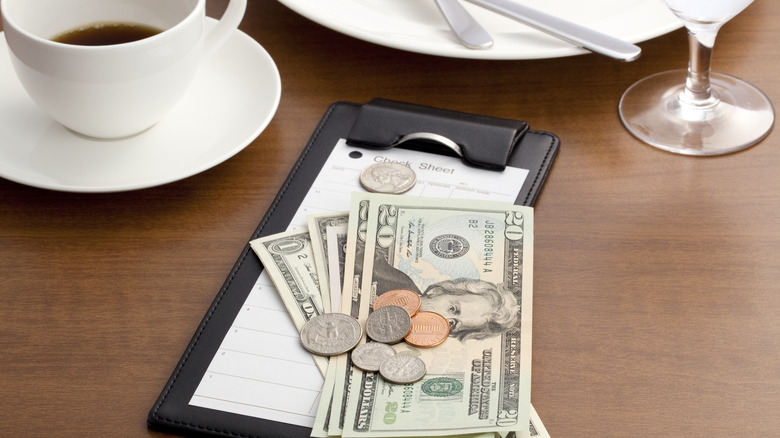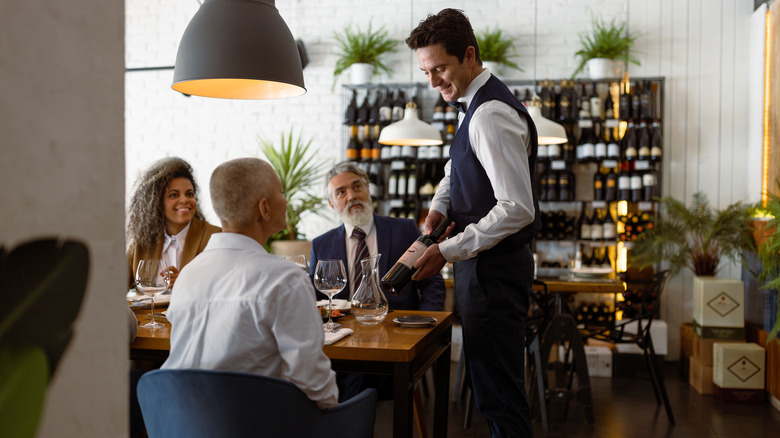The Dark History Behind Tipping In Restaurants
Tipping as a custom has a problematic history. It started in medieval Europe where it originated as a way for the upper class to reward their servants. Class continued to play a role in the practice when it was transplanted to the U.S. in the 19th century, but so, too, did race.
Tipping became common after the Civil War, during what is known as the Reconstruction Era, and its first major exponent was The Pullman Company. This operator of railroad sleeping and dining cars hired a predominantly Black workforce (many of them formerly enslaved) to serve as its porters but paid them very little money. Tipping was thus promoted to railway travelers as a recompense for the low wages paid to workers, allowing The Pullman Co. to save massive sums on below-market labor costs — in 1916 alone, the company pocketed a projected $2.5 million due to its low pay rates (per Restaurant Business).
Pullman wasn't the only business to benefit from the gratuity model. Many Black workers received no wages during this era and thus relied solely on tips to make money. However, by the early 20th century, several states had banned tipping, but the reversal was temporary. All of these laws were overturned by the 1920s — the decade in which tipping became more widespread due to Prohibition.
The evolution of tipping in restaurants
Until the early 1900s, American hotels largely discouraged tipping, which they saw as a means of bribing staff for larger meal portions. Once hotels began shifting from an American to a European meal plan, however — meaning restaurant service was now billed separately from accommodations — management began looking upon the practice more favorably.
Prohibition also helped to promote tipping, as hotel owners looked to recoup the revenue lost from legal alcohol sales. The solution, frequently, was to turn hotel bars into another restaurant venue, with tipping encouraged by employers, so they could cut costs on waitstaff wages. Tipping did become more widespread during this era, increasing in both frequency and the amounts given, leading more Americans to accept it as an established national custom. In the 19th century, by contrast, many of the nation's citizens viewed it as undemocratic.
The first minimum wage law wasn't introduced until 1938, but restaurant workers weren't included in the pay protections. That didn't occur until 1966 and even then, service staff were only guaranteed a tip credit that ensured wages and tips combined would exceed the minimum state standard.
Why many people still find tipping problematic
The etiquette rule for so-called good or bad tippers has evolved over the years, rising from 10% in the 1950s to 15% by the 1970s. Nowadays, of course, a tip of 20% or more is the standard although that etiquette can be complicated by tipping on top of a restaurant's service fee.
Despite the standard, the typical tip in the U.S. is currently about 18%, with slight differences reported based on income education and other factors, including location. Residents of California and Missouri are the best tippers, for example, while Illinoisans and Mississippians tip the least, on average, per USA Today.
About two-thirds of Americans now say they feel pressured to increase their tips, and nearly half are tired of being prompted to leave gratuities, statistics that help to explain the rise in what's known as "tipping fatigue." Several restaurant owners have also expressed dissatisfaction with the tipping model in recent years — restaurateur Danny Meyer was at the forefront of the anti-tipping movement — highlighting the obvious fact that it's flawed and has been since it was introduced in the 19th century. But then, as now, tips are important to workers in the hospitality industry, who still often make very low — unlivable — wages without them.



